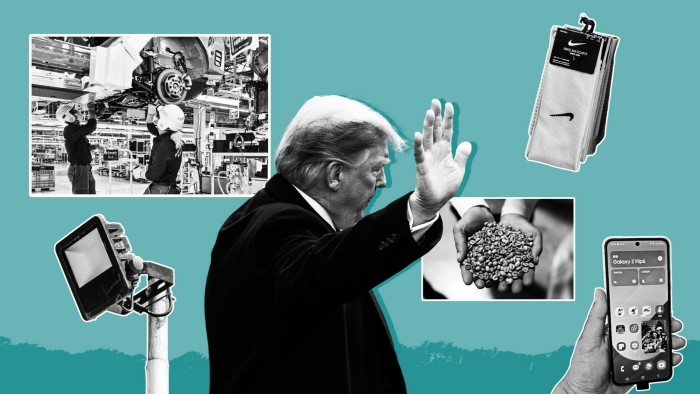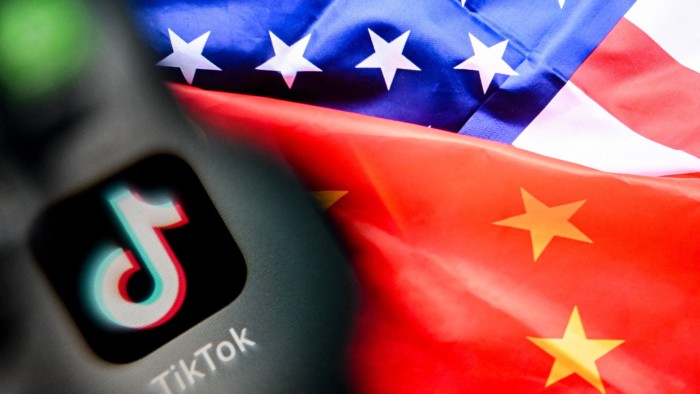As Asia’s manufacturing powerhouses try to stave off punishing US tariffs ahead of Donald Trump’s July 9 deadline, exporters across the region are rushing out orders, cutting prices, looking for new customers and rethinking their relationship with the world’s biggest economy.
Trump’s blanket 10 per cent tariff has already hurt countries reliant on exports to the US for growth, jobs and foreign exchange — and the higher rates the US president has vowed to impose unless they negotiate new trade deals could be devastating.
Financial Times reporters spoke to textile producers, electronics manufacturers and car suppliers trying to make sense of a market in turmoil.
The Nike supplier looking to open factories elsewhere

Pakistan
29%
Reciprocal tariff
Buy a pair of Nike-branded socks and there is a good chance it came from Interloop, one of Pakistan’s largest textile exporters. Interloop sells roughly $220mn worth of goods to the US every year, supplying about 40 per cent of Nike’s socks and a similar proportion of big-box retailer Target’s branded clothes.
In the wake of Trump’s 10 per cent universal tariff, Interloop had to cut prices for Target. A threatened 29 per cent tariff on goods sold to the US, its biggest customer, could be devastating, said Musadaq Zulqarnain, chief executive. “We have loyal, long-term customers who I think would stay for 12 to 18 months, even with 29 per cent tariffs,” Zulqarnain said. “But beyond that, I am very concerned.”
How much of this production stays in Pakistan depends on the deal struck with Trump, not just by Islamabad but also rival garment producers, such as Bangladesh and Vietnam. If tariffs end up lower in Bangladesh, Interloop may revive a mothballed factory there. Interloop, which also operates plants in China and Sri Lanka, has sped up plans to open a factory in Egypt, which faces only a 10 per cent tariff.
Meanwhile, the search is on for new buyers in Europe, including Russia, but Zulqarnain fears “fierce competition” from Chinese producers, which have lower costs even after potentially higher tariffs.
“If demand goes down [because of tariffs], we can maybe sustain people staying at home for two or three months,” Zulqarnain said. “After that, we would have to begin lay-offs.” Humza Jilani in Islamabad
The LED maker who thinks the US is becoming less important

China
55%
Total tariff
Demand was so great for Charming LED’s floodlights, LED screens and lighting controls that the Chinese company opened a sales office in Los Angeles in 2016 — the year Trump first won the presidency.
Trump slapped tariffs on China in his first term. Yet nearly a decade later, such is China’s dominance of the lighting supply chain — it accounts for 95 per cent of US imports of LED lamps — that it holds the upper hand with customers, said Wang Chengming, marketing director at Charming LED.
“Basically, American consumers will pay for us. We are not the ones who are anxious,” he said, adding that rival manufacturing hubs such as India lacked the infrastructure to compete, while the US was unable to produce comparable goods. “Chinese products are good and cheap, so why should they go to other countries?”
Since Washington and Beijing agreed a truce and a 90-day pause on additional tariffs of 145 per cent on Chinese exports, several US customers had resumed shipping orders, he said. While the initial deal faltered, Trump said on June 11 that the total tariff on China would be 55 per cent.
Wang’s customers’ orders are shipped “free on board” from departure ports, meaning customers are responsible for logistics and tariff costs once goods are loaded on to vessels at Chinese ports. Some buyers are reported to ship their goods to third countries in order to disguise their Chinese origin for tariff purposes, a process known as origin washing. “We only guarantee that [the orders] get to the ports and leave the ports . . . after they get there, I don’t know what happens to them.”
Charming sells its goods in 160 countries. Ultimately, Wang said, the US will become “less and less important” for Chinese suppliers, who will focus on other markets, including Europe, Asia and in China.
“It used to be very important,” he said of the US. “But [US tariffs] won’t impact us. It’s just one part of the market. The US does not represent the whole world.” Will Langley in Guangzhou
The chipmaker who will struggle to cut costs

South Korea
25%
Reciprocal tariff
As a supplier of chips for Samsung Electronics and Chinese smartphone makers, South Korea’s Dongwoon Anatech is right in the crosshairs of Trump’s trade wars. Trump threatened Apple and Samsung with 25 per cent tariffs on their devices unless they shift production to the US, while Chinese smartphone exporters also face hefty tariffs.
Samsung, Dongwoon’s main customer, had not asked for price cuts, but if the US makes good on its threat, it certainly will, said Kim Dong-cheol, the chief executive of the leading producer of optimal image stabilisation and autofocus chips that prevent camera shake and automatically determines the focus point to boost picture quality.
South Korea’s strict labour laws make it hard to pare outgoings, Kim said. “There is a limit to cost-cutting,” he said.
With that in mind, Dongwoon wants to expand in the Chinese market, where smartphone customers mostly sell goods domestically, or in south-east Asia and Europe. While it does have competitors in China, Dongwoon is long established and remains a step ahead, Kim said, both in terms of design and customer service.
Still pressure for price cuts remains, and not just from Samsung, Dongwoon said — its auto customers, Hyundai Motor and its affiliate Kia, will probably follow suit. Again, he sees the way forward as boosting sales to companies and countries less exposed to US tariffs. Song Jung-a
The coffee producer who sees the US market as a stepping stone

Vietnam
46%
Reciprocal tariff
Coffee producer Vuong Thanh Cong Holding had a shipment of organic beans and ground coffee from Vietnam’s central highlands en route to the US the day Trump slapped a 46 per cent tariff on the country’s exports. Fearing cancellation by its US customer, Vuong Thanh Cong offered hefty discounts and took the loss.
In recent years, more and more manufacturers, fearing export curbs and tariffs, have moved to Vietnam as part of a growing “China plus one” strategy to redraw global supply chains. Yet Vietnam is also a big commodity producer, the world’s second-largest exporter of coffee after Brazil. The US accounts for nearly half of Vuong Thanh Cong’s exports.
Chief executive Nguyen Van Hiep expects the coming months to involve more of the same — offering discounts to American buyers to maintain access to the US market. In the long run, he hopes, their presence in America will help them gain exposure and access to other markets.
“We have decided to accept some losses in the US market and use our access to the US market as quality proof to get access to other markets,” said Hiep. The losses may also be short-term. “If the Democrats or other people come into power in the US, it may change.”
Still, the 46 per cent levy — if it sticks — would result in a 15 per cent decline in the company’s monthly profits, the chief executive said. Ultimately, it makes sense to look elsewhere. “In the future, the US market will be an important market, but it’s not the only market.” A.Anantha Lakshmi
The auto component firm offering customers a choice of global factories

Japan
25%
Auto tariffs
With factories in 15 countries, Japanese auto supplier NOK has tried to make it easier for customers to negotiate tariffs and supply chain turmoil by offering them a choice, even going so far as to offer a menu of options.
“Since our competitors without a US base must export from places like Japan, Mexico, Canada or China, we’ve started communicating to our customers that we can supply them from within the US — and because of that, there’s a chance our volumes will rise,” said chief executive Masao Tsuru.
Even so, car companies must go through lengthy approval processes for new parts that mean they cannot change their suppliers easily or quickly.
Its global network of factories is an advantage for NOK, as is the fact that unusually among Japanese auto suppliers, it has not tied its fortunes to a single domestic car producer and has instead long courted European, American and Chinese customers. Analysts, including Bernstein, say Japanese car producers could be among the worst hit by tariffs, which are 25 per cent for auto-related goods and 24 per cent on other items.
The future for NOK may lie not just outside Japan, but also ever more outside the US. Its plan — as well as diversifying into heavy duty machinery, semiconductor parts and energy — is to grow its business with Chinese EV makers. Tsuru is also on the hunt for acquisitions, particularly suppliers hit by the tariffs whose products can be integrated into its US supply chain or help accelerate its pivot away from cars. Harry Dempsey







